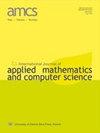Generation of Synchronizing State Machines from a Transition System: A Region–Based Approach
IF 1.2
4区 计算机科学
Q3 AUTOMATION & CONTROL SYSTEMS
International Journal of Applied Mathematics and Computer Science
Pub Date : 2023-03-01
DOI:10.34768/amcs-2023-0011
引用次数: 0
Abstract
Abstract Transition systems (TSs) and Petri nets (PNs) are important models of computation ubiquitous in formal methods for modeling systems. A crucial problem is how to extract, from a given TS, a PN whose reachability graph is equivalent (with a suitable notion of equivalence) to the original TS. This paper addresses the decomposition of transition systems into synchronizing state machines (SMs), which are a class of Petri nets where each transition has one incoming and one outgoing arc. Furthermore, all reachable markings (non-negative vectors representing the number of tokens for each place) of an SM have only one marked place with only one token. This is a significant case of the general problem of extracting a PN from a TS. The decomposition is based on the theory of regions, and it is shown that a property of regions called excitation-closure is a sufficient condition to guarantee the equivalence between the original TS and a decomposition into SMs. An efficient algorithm is provided which solves the problem by reducing its critical steps to the maximal independent set problem (to compute a minimal set of irredundant SMs) or to satisfiability (to merge the SMs). We report experimental results that show a good trade-off between quality of results vs. computation time.从转换系统生成同步状态机:基于区域的方法
过渡系统(TSs)和Petri网(PNs)是系统建模形式化方法中普遍存在的重要计算模型。一个关键问题是如何从给定的TS中提取出一个可达图与原始TS等效的PN。本文将转换系统分解为同步状态机(SMs), SMs是一类Petri网,其中每个转换都有一个传入和一个传出弧。此外,SM的所有可达标记(表示每个位置的标记数量的非负向量)只有一个标记的位置,只有一个标记。这是从TS中提取PN的一般问题的一个重要案例。该分解基于区域理论,并证明了称为激励闭合的区域性质是保证原始TS与分解成SMs之间等价的充分条件。给出了一种有效的算法,通过将其关键步骤简化为最大独立集问题(计算最小冗余SMs集)或可满足性问题(合并SMs)来解决问题。我们报告的实验结果显示了结果质量与计算时间之间的良好权衡。
本文章由计算机程序翻译,如有差异,请以英文原文为准。
求助全文
约1分钟内获得全文
求助全文
来源期刊
CiteScore
4.10
自引率
21.10%
发文量
0
审稿时长
4.2 months
期刊介绍:
The International Journal of Applied Mathematics and Computer Science is a quarterly published in Poland since 1991 by the University of Zielona Góra in partnership with De Gruyter Poland (Sciendo) and Lubuskie Scientific Society, under the auspices of the Committee on Automatic Control and Robotics of the Polish Academy of Sciences.
The journal strives to meet the demand for the presentation of interdisciplinary research in various fields related to control theory, applied mathematics, scientific computing and computer science. In particular, it publishes high quality original research results in the following areas:
-modern control theory and practice-
artificial intelligence methods and their applications-
applied mathematics and mathematical optimisation techniques-
mathematical methods in engineering, computer science, and biology.

 求助内容:
求助内容: 应助结果提醒方式:
应助结果提醒方式:


